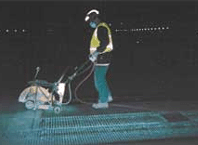Trimming Stone, Cutting Costs
By Tom Inglesby
 The fabrication shops are well equipped for cutting limestone, granite and other 'rocks.' Taking some of that technology into the field makes the mason's job easier and less costly.
The fabrication shops are well equipped for cutting limestone, granite and other 'rocks.' Taking some of that technology into the field makes the mason's job easier and less costly.
When we went onsite at the Pentagon for the special report in August, we were impressed by the ability of Bybee Stone, Elletsville, Ind. and Masonry Arts, Bessemer, Ala., to rebuild the 60-year old building in material that had to meet exacting standards of historical accuracy. The limestone Bybee supplied came from fields, some near the sources of the original stone, that had already been shut down for the winter. Taking blocks of stone that were "just sitting around" and cutting them to reproduce the texture of the original, damaged fa?ade's limestone required care and equipment suitable for the job.
Once the stone arrived at the Pentagon, as is always the case, some had to be "adjusted" with field cuts. Remember, the stone had been fabricated using drawings from 1942 ? which had been modified on a daily basis during the original construction according to contemporary reports. And even then, the drawings they first found were not for the elevation that was damaged but for a similar one on another part of the building. That put pressure on Masonry Arts to do onsite trimming with extreme care to prevent waste and assure fit while maintain historical visual accuracy.
During the research for the Pentagon series, we talked with some of the equipment and tool suppliers to Masonry Arts. One ? World Diamond Source, Pompano Beach, Fla. ? provided the blades that allowed those custom cuts. As we were researching this month's feature on stone cutting, it was obvious that World Diamond Source could provide us, too, with valuable resources.
Matt Shrater, regional accounts manager for the mid-Atlantic, and Cliff Maddock, president and co-owner, with his brother, of World Diamond Source agreed to sit down for a discussion of blades for stone cutting. Here is what we learned.
"On the Pentagon, they were doing granite and limestone," recalls Maddock. "Masonry Arts buys a lot of seven-inch turbo blades from us and we have about 20 different bond hardness ratings for those blades. To cut a soft limestone, blue stone, or sandstone, something that is softer, and therefore more abrasive, you need a hard bond holding the diamond within the segment."
He adds, "If you have too soft of a bond when working on soft abrasive material, it's going to cut fine, it's going cut extremely fast, but you're going to prematurely wear the blade out. It's like rubbing your hand on the street ? your skin is going to peel away. That's what a soft bonded blade does on soft material."
The opposite is true ? if you're cutting a hard material, then you need a soft bond. If you have too hard a bond when cutting hard material, the blade is not going to cut, it's going to deflect and bounce off the material.
What makes a stone blade different than a brick or block blade? "With a stone blade you have different grit or mesh sizes of the diamond," begins Maddock. "You have different diamond concentrations, different diamond grades, different bonds. You can use more of one material and less of another to harden or soften the blade or make the blade cut faster or last longer. There are many different binding metals that can be used: tungsten carbide, cobalt, iron or nickel, for example. We can use different percentages of different metals in the blade."
 No one can copy another company's blade exactly due to all these combinations. If a contractor loves one company's particular blade, the competition might buy the blade, take it into their laboratory and analyze the metallurgical composition. That will tell them the metals used but they would still be unlikely to reproduce it exactly.
No one can copy another company's blade exactly due to all these combinations. If a contractor loves one company's particular blade, the competition might buy the blade, take it into their laboratory and analyze the metallurgical composition. That will tell them the metals used but they would still be unlikely to reproduce it exactly.
"You have to know the engineer who made the blade," claims Maddock. "That's because they can bake it a certain way when they make the segments. They are put through a heat process that hardens the metals ? like cooking them. They can put in at different temperatures for different amounts of time. In layman's terms, how long they bake the segment, and how hot they do it, can make the blade react differently."
You're better off spending the money on a good blade because "you pay for what you get" in a diamond blade. Maddock adds, "You have to play around with bonds, diamond grades, diamond grits and diamond qualities. You can vary all of those things; grade, grit, quality and size. They are all factors in the performance of the blade, along with all the metal bond components. There are variables of cobalt, tungsten carbide, etc. That's where the blade engineer comes in."
"If people are cutting granite on the sides of buildings with concrete behind it," notes Shrater, "using handheld saws with 12-inch and 14-inch blades and they are looking for blade life, I recommend a segmented blade. If they are looking for fast cuts, and not concerned about blade life but they do need a decent finish, I'd go with a turbo blade. If they're looking for a chip-free finish, I'd go with a continuous rim blade."
With his boss sitting next to him, Shrater adds, "This is where the salesmen need to know the application. We go on the jobsite with our customers to be sure we understand what the material is like and what blade to recommend."
To which Maddock comments, "Before a customer goes out and cuts some of those 'rocks,' we'll ask them to send us samples. We sit in the yard behind our offices, testing it with different equipment until we get them the blade they need. I tell the salesmen, if you're not sure of something, don't lie to the customer, find the answer or test the material. Different customers have different needs. With the salesmen asking the right questions, we can get the customer into the right product."
Maddock says he's a hands-on owner who deals with a lot of innovative products. So, where is the diamond blade business going in regard to cutting stone? "What we are doing is looking for ways to make things more efficient or make the product last longer. Every day I'm on the Internet with China and Korea, and factories here in the U.S., dealing with how can we make it better for the customer, or less expensive to cut our customers' costs down. If we're not saving them money, we're not doing our job.
"The big thing now is the quietness of blades," he continues. "That is a problem, of course, for stone fabricators. In the fabrication shops where they're using the big bridge saws to cut huge slabs into usable pieces, it's very loud. So they are putting copper in the middle of the cores of diamond blades, to cut the noise while they are cutting the stone."
If you have a three-layer blade with tool steel on the outside and copper in the middle ? a sandwich core ? the sound is much quieter. "It's changed a lot of people's lives in the stone fabrication shops over the years," says Maddock. "Now they're starting to do it the same way for the masonry market because OSHA is cracking down on noise on job sites."
Shrater chimes in, "If our customers have anything that they think might work better, give us the idea. That's the number one thing we tell our customers, 'You guys are out there doing the work, if you have something you think might work better, tell us.' And they do tell us. Every day somebody gives us a new idea how we can change or better something."
About the Author
Tom Inglesby is a San Diego-based freelance writer whose work has appeared in numerous online and print publications. He is the winner of the Construction Writers Association's 2002 Boger Award for Special Reports.


















